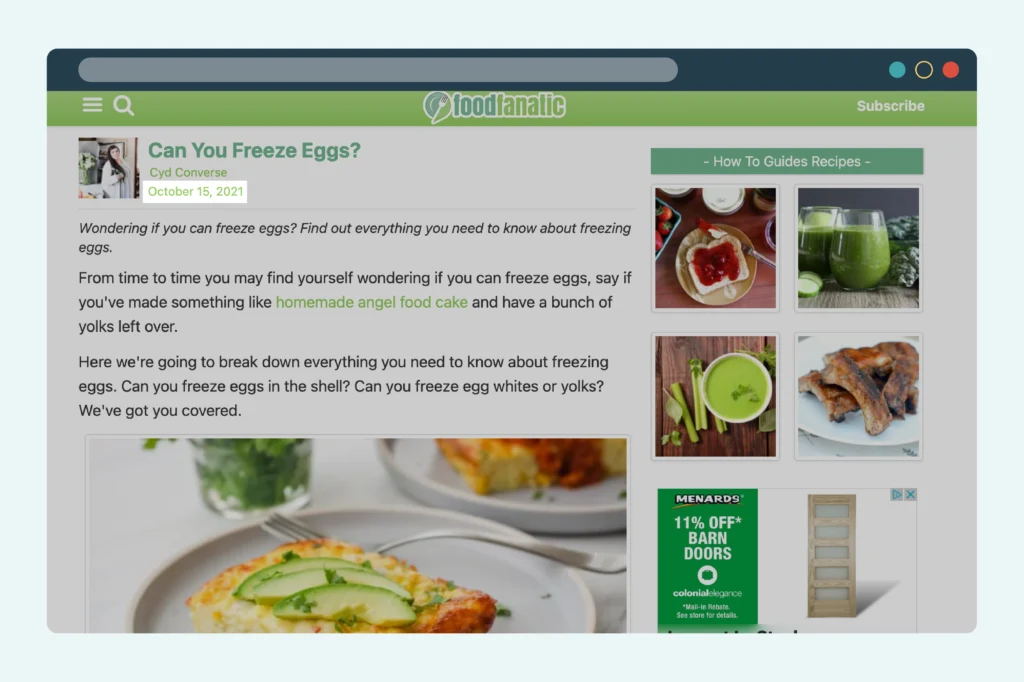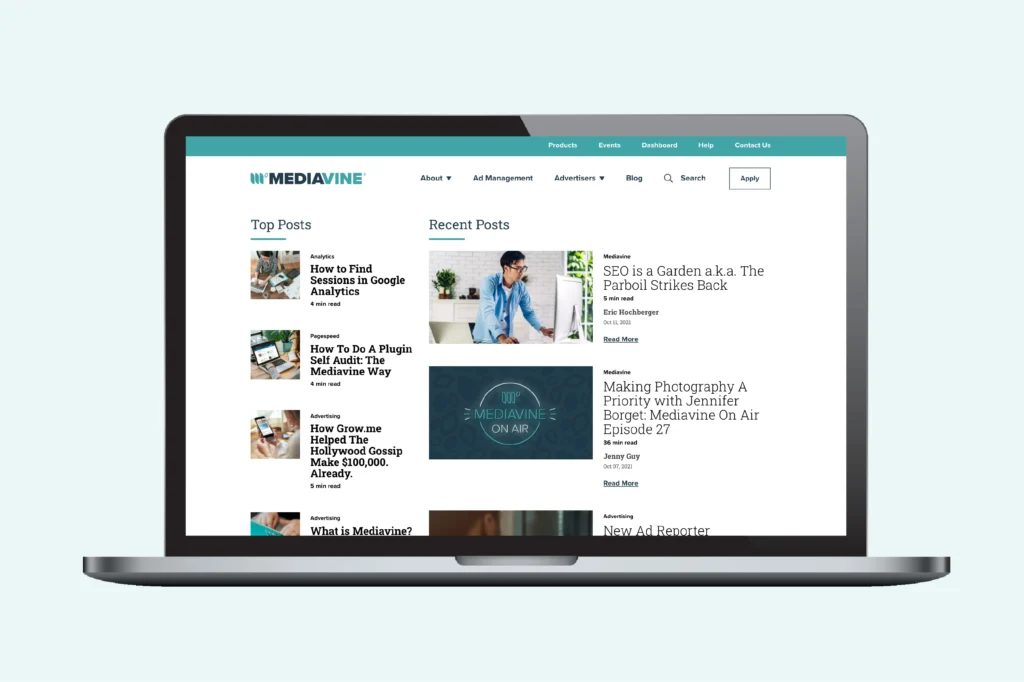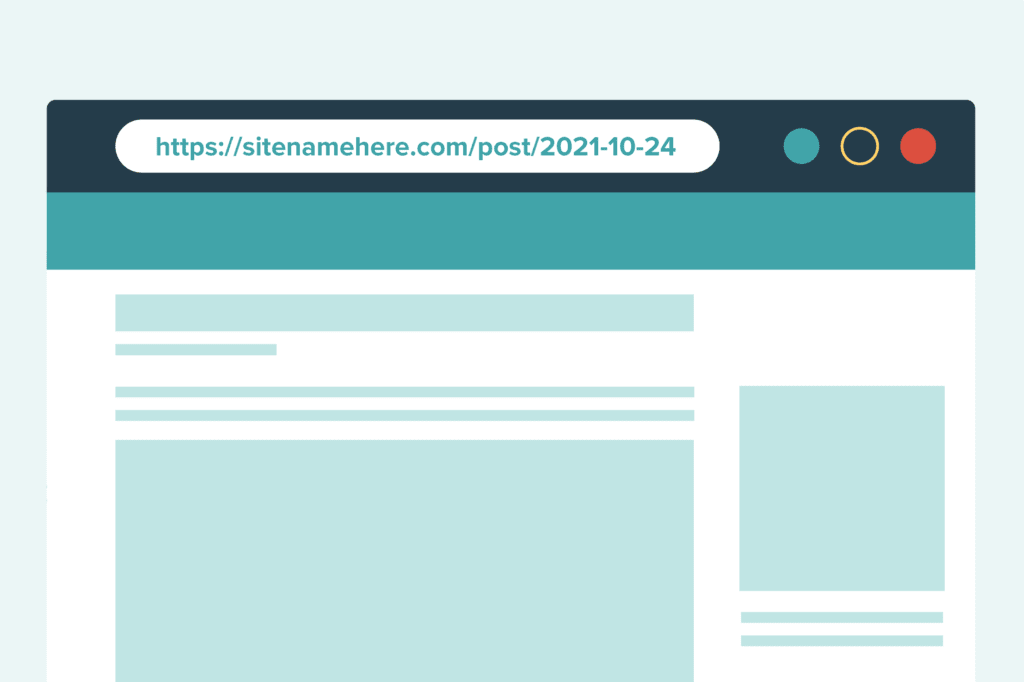Should I Republish Content? There’s a Better Way


Whether it’s for SEO or monetization purposes, we always encourage publishers to update old content.
We’ve discussed at length how specifically to update content to improve RPM and optimize for SEO, but today we’re focusing on a specific and surprisingly controversial aspect.
How to handle the modified and published date may not seem significant, but it can make a big difference when it comes to how your content is presented to Google and users.
Make eye contact and don’t talk about yourself the whole time. Just kidding. (Although that is generally good advice.)
When it comes to the calendar dates displayed on posts, Google recommends displaying a visible date – as in something users can see – while also outputting the date using Article schema.
Google requires that you output a published date (in schema), and recommends that you output the modified or updated time on the post as well.
The company’s specific threshold for when you should change the visible date to the user is when you’ve made substantial changes to the content.
Keep in mind that these are best practices, which differ from policies – violations of which can result in actual, punitive action against your site.
What we’ve discussed so far applies to your content and organic search results. Google News publishers must comply with a more specific set of guidelines.
If you’ve submitted your website to Google News via the Google Publisher Center, there are somewhat stricter policies for republishing.
[Side note: If you haven’t submitted your site, you should. Despite its name, Google News will also accept lifestyle sites, such as our own Food Fanatic, as approved publications.]
Google News’ best practices are roughly the same as for regular Google search results, but the publication date is required in order for the content to appear at all.
When it comes to Google News specifically:

If this sounds too strict and makes you wary of Google News, it shouldn’t.
Most of these bullet points are more or less the same as Google’s regular best practices, and Google News can be a substantial source of traffic.
The significant difference for those publishing in Google News when compared to publishers at large? As of now, republishing for the sake of reappearing in Google News can cause a penalty, all the way up to a potential removal from Google News.
Google recommends you show a published and/or updated date to a user. In that same Advanced SEO article, they advise only showing one date if Google is getting confused.
Given these two pieces of advice, combined with our own experience, we recommend showing only the updated date to readers, assuring Google will show the freshest date.
Your theme should hopefully support this (Trellis does, apologies for the shameless plug), but if not, you should be able to accomplish this with a quick filter.
Remember that Google will see the published date via your schema, and via your Google News site map if your SEO plugin is outputting one for you.
Per Google’s best practices, no. You should be changing the updated, or modified date, leaving the published date as the original date.
Still, we know a lot of publishers are doing this, undoubtedly with good intentions.
Hear us out and we’ll explain why it’s a common practice, but not necessarily the best one – and how there’s a better way to achieve our shared goals.
It’s no secret that Google and readers love fresh content.
Taking a 2017 article, giving it a 2021 date and republishing with some new content can often result in more clicks from search results and potentially a boost in your rankings.
Which is great, but correlation is not causation here.
A lot of that boost comes not from republishing the post, but from a side effect of republishing – the simple act of bringing that post back into your feed.
If you change only the modified date and bump the article back on to your homepage, you’ll effectively get the same boost without going against best practices or policies.
How do I do that, you’re asking?
We’ll tell you!
To fully replicate the benefits of appearing in the feed – homepage links, showing up to RSS readers, appearing on category pages, etc. – you’ll need to change the WordPress “loop.”
The biggest benefit of republishing is that precious homepage link – and you can get this with any static homepage through a “recently updated” section, or manually placing it inside a “featured” or “top post” area (or whatever you choose to name it).

There are plenty of plugins that will let you change the order in which posts appear; you might be able to sort by modified dates, or manually push certain posts to the top.
For category links, you can create static category pages, or even add links inside the category description if your theme supports outputting that (like Trellis, which by design is optimized for SEO best practices).
Alternatively, you could use the “sticky” feature of WordPress to instantly jump to the top of category and feed pages. You’ll just have to remove this later on.
Mediavine-owned sites use a custom CMS (not WordPress) which includes a feature enabling us to re-insert posts at any point in the feed without changing the publication date.
The long and short of it: There are lots of ways to reap the benefits you might get from changing the publication date, without running afoul of Google or altering the space-time continuum.
Your main goal should always be getting internal links to fresh content you just updated. Everything we’ve just described is just one piece of the puzzle.
Go through your related content and add new links. That plus a homepage link will take you a lot further than republishing ever could.
Whether it’s regarding republishing or anything else, we’re here to tell you what we believe is the best course of action, based on our own experience and Google’s own guidance.
At the same time, we understand that if every component of SEO were an exact science, there wouldn’t even be SEO, because everyone would follow the same exact rules to the letter.
SEO experts are going to differ on certain topics, and this is one of them. Some believe strongly in republishing, as we’ve just discouraged you from doing.
If you want to trust them, and you aren’t a Google News publisher, you’ll probably be alright. We still don’t suggest this, but if you go that route, at least consider this the intent behind what we’re advocating.
These best practices are in place, and Google News has stricter policies on top of those, for a reason: Google doesn’t want to confuse or mislead readers. Neither do you (we hope).
Unless you’re attempting to deceive Google by changing the publication date to artificially improve rankings, or bump yourself back up in Google News on an old story, you’ll likely be fine.
Just make sure you’ve actually made substantial changes if you’re changing the publication date. Did you change the headline, add new photos, add or replace significant content, etc.?
Put yourself in your readers’ shoes. If they just saw this same article yesterday and again today. Would it read like two different posts? If so, a new publication date will probably not hurt you.
It’s important to note that if you have dates built into your URLs, you should not republish posts.

Doing so will cause a change in the permalink of the post, causing a redirect. Whatever SEO expert or experts you listen to on this subject, you really don’t want to do this.
If you have dates in your URLs, I’d recommend following best practices, changing the modified date and finding a way to get that link using methods like we described above.
If you can, try to follow Google best practices and Mediavine’s best of both worlds approach.
Stay up to date with the latest from Mediavine
Publishers spend time creating great content that keeps readers coming back, and we know that safeguarding that content and maintaining control over how it’s used are critical concerns in today’s …
 Eric Hochberger
Eric Hochberger
In a blog post last week, Google announced plans to launch generative AI into Search Labs with a new product called Search Generative Experience (SGE). What exactly is SGE, and …
Since ChatGPT’s release in November 2022, OpenAI’s prototype of generative AI — that is, artificial intelligence that can produce new content on demand — has dominated popular tech media. We’ve …